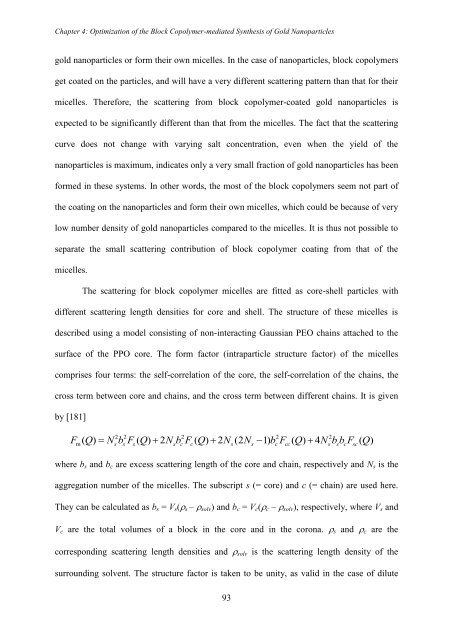PHYS01200704032 Debes Ray - Homi Bhabha National Institute
PHYS01200704032 Debes Ray - Homi Bhabha National Institute
PHYS01200704032 Debes Ray - Homi Bhabha National Institute
You also want an ePaper? Increase the reach of your titles
YUMPU automatically turns print PDFs into web optimized ePapers that Google loves.
Chapter 4: Optimization of the Block Copolymer-mediated Synthesis of Gold Nanoparticles<br />
gold nanoparticles or form their own micelles. In the case of nanoparticles, block copolymers<br />
get coated on the particles, and will have a very different scattering pattern than that for their<br />
micelles. Therefore, the scattering from block copolymer-coated gold nanoparticles is<br />
expected to be significantly different than that from the micelles. The fact that the scattering<br />
curve does not change with varying salt concentration, even when the yield of the<br />
nanoparticles is maximum, indicates only a very small fraction of gold nanoparticles has been<br />
formed in these systems. In other words, the most of the block copolymers seem not part of<br />
the coating on the nanoparticles and form their own micelles, which could be because of very<br />
low number density of gold nanoparticles compared to the micelles. It is thus not possible to<br />
separate the small scattering contribution of block copolymer coating from that of the<br />
micelles.<br />
The scattering for block copolymer micelles are fitted as core-shell particles with<br />
different scattering length densities for core and shell. The structure of these micelles is<br />
described using a model consisting of non-interacting Gaussian PEO chains attached to the<br />
surface of the PPO core. The form factor (intraparticle structure factor) of the micelles<br />
comprises four terms: the self-correlation of the core, the self-correlation of the chains, the<br />
cross term between core and chains, and the cross term between different chains. It is given<br />
by [181]<br />
F Q N b F Q N b F Q N N b F Q N b b F Q<br />
2 2 2 2 2<br />
m<br />
( ) <br />
s s s( ) 2<br />
s c c( ) 2<br />
s(2 s<br />
1) c cc<br />
( ) 4<br />
s s c sc( )<br />
where b s and b c are excess scattering length of the core and chain, respectively and N s is the<br />
aggregation number of the micelles. The subscript s (= core) and c (= chain) are used here.<br />
They can be calculated as b s = V s ( s – solv ) and b c = V c ( c – solv ), respectively, where V s and<br />
V c are the total volumes of a block in the core and in the corona. s and c are the<br />
corresponding scattering length densities and solv is the scattering length density of the<br />
surrounding solvent. The structure factor is taken to be unity, as valid in the case of dilute<br />
93

















